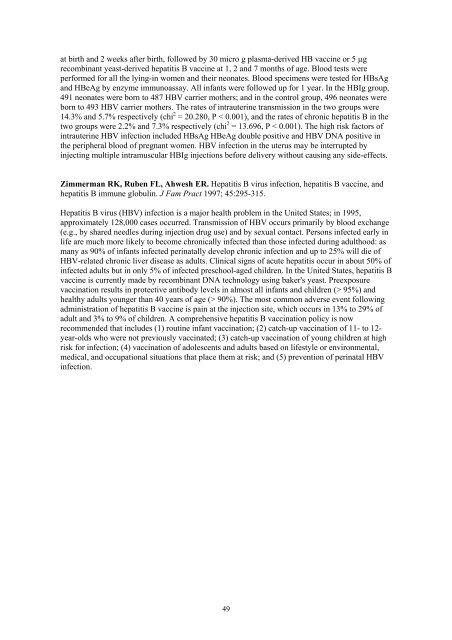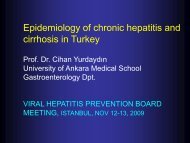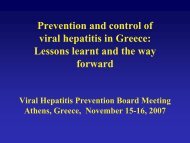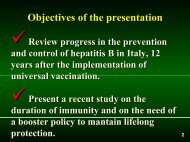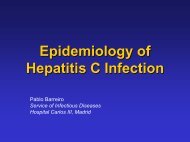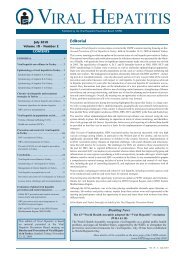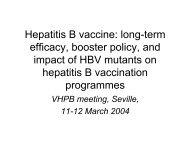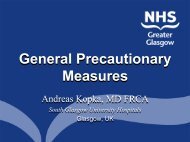<strong>in</strong>trauter<strong>in</strong>e <strong>in</strong>fection by <strong>hepatitis</strong> B <strong>virus</strong> (HBV) <strong>and</strong> to <strong>in</strong>vestigate its mechanism. Forty-eightpregnant women positive for <strong>hepatitis</strong> B surface antigen (HBsAg) were r<strong>and</strong>omly divided <strong>in</strong>to 2groups. The 34 women <strong>in</strong> the study group were <strong>in</strong>jected with HBIg dur<strong>in</strong>g pregnancy; the other 14women were <strong>control</strong>s. Maternal blood samples were taken before HBIg <strong>in</strong>jection <strong>and</strong> at delivery.Neonatal blood samples were taken with<strong>in</strong> 24 hours after birth before HBIg <strong>and</strong> <strong>hepatitis</strong> Bvacc<strong>in</strong>e were given. HBsAg <strong>and</strong> antibody to HBsAg (anti-HBs) were tested by radioimmunoassay.None <strong>of</strong> the 35 newborns (<strong>in</strong>clud<strong>in</strong>g 2 tw<strong>in</strong>s) <strong>in</strong> the study group was positive for HBsAg, but 3(21%) <strong>in</strong> the <strong>control</strong> group were positive (P = 0.02). The HBsAg titers <strong>in</strong> the women <strong>in</strong> the studygroup decreased after HBIg <strong>in</strong>jection. Of the 35 newborns <strong>in</strong> the study group, 32 (91%) werepositive for anti-HBs. Systematic <strong>in</strong>jections <strong>of</strong> HBIg dur<strong>in</strong>g pregnancy may prevent <strong>in</strong>trauter<strong>in</strong>eHBV <strong>in</strong>fection, the mechanism <strong>of</strong> which may be reduction <strong>of</strong> maternal HBV viremia <strong>and</strong>production <strong>of</strong> fetal passive immunity.Zamir C, Dagan R, Zamir D, Rishpon S, Fraser D, Rimon N, Ben Porath E. Evaluation <strong>of</strong>screen<strong>in</strong>g for <strong>hepatitis</strong> B surface antigen dur<strong>in</strong>g pregnancy <strong>in</strong> a population with a high prevalence<strong>of</strong> <strong>hepatitis</strong> B surface antigen-positive/<strong>hepatitis</strong> B e antigen-negative carriers. Pediatr Infect Dis J1999; 18:262-266.Sub-District Health Office, Hadera, Israel. hdrzamir@matat.health.gov.ilUniversal <strong>hepatitis</strong> B vacc<strong>in</strong>ation <strong>in</strong> <strong>in</strong>fancy was implemented <strong>in</strong> Israel <strong>in</strong> 1992. The programconsists <strong>of</strong> active vacc<strong>in</strong>ation at birth <strong>and</strong> at 1 <strong>and</strong> 6 months <strong>of</strong> age, without <strong>hepatitis</strong> B surfaceantigen (HBsAg) screen<strong>in</strong>g dur<strong>in</strong>g pregnancy. Infants <strong>of</strong> HBsAg carrier mothers do not receivespecific <strong>hepatitis</strong> B immunoglobul<strong>in</strong> <strong>in</strong> addition to vacc<strong>in</strong>e at birth. The recently arrived Jewishimmigrants from Ethiopia are the group with the highest rate <strong>of</strong> HBsAg carriage (approximately10%) <strong>in</strong> Israel. The objective <strong>of</strong> this study was to evaluate whether the present policy is effectiveaga<strong>in</strong>st <strong>per<strong>in</strong>atal</strong> HBV <strong>transmission</strong> from mothers <strong>of</strong> Ethiopian orig<strong>in</strong> to their <strong>in</strong>fants. The studygroup <strong>in</strong>cluded 411 Israeli born children, <strong>of</strong>fspr<strong>in</strong>g <strong>of</strong> mothers <strong>of</strong> Ethiopian orig<strong>in</strong>. All <strong>in</strong>fants werefully vacc<strong>in</strong>ated start<strong>in</strong>g at birth. Sera were collected from the children at the age <strong>of</strong> 9 to 36 months<strong>and</strong> from their mothers. Tests for HBsAg, antibodies to HBsAg (anti-HBs) <strong>and</strong> antibodies to<strong>hepatitis</strong> B core antigen (anti-HBc) were performed. Eighty-n<strong>in</strong>e percent <strong>of</strong> the children haddetectable anti-HBs, <strong>in</strong>clud<strong>in</strong>g 82.2% with protective anti-HBs concentrations (> or = 10 mIU/ml). Although 24 mothers (6.2%) were HBsAg carriers, none <strong>of</strong> the children was HBsAg-positive.Seven <strong>of</strong> 394 <strong>in</strong>fants (1.7%) tested positive for anti-HBc. This test became negative <strong>in</strong> 5 <strong>of</strong> 6 whowere followed for 12 months. The percentage <strong>of</strong> <strong>in</strong>fants with protective anti-HBs concentrationsdecreased significantly from 91.4% at 9 to 12 months to 70.1% at 31 to 36 months <strong>of</strong> age. Themother's <strong>in</strong>fection status was not associated with the <strong>in</strong>fant's response to vacc<strong>in</strong>e. Calculationbased on the above data suggests that screen<strong>in</strong>g for HBsAg <strong>in</strong> pregnancy <strong>in</strong> that group is not costeffective.Our results suggest that the Israeli vacc<strong>in</strong>ation program aga<strong>in</strong>st HBV <strong>in</strong>fection iseffective, even <strong>in</strong> a high risk population, <strong>and</strong> additional measures are not cost-effective.Zhu Q, Yu G, Yu H, Lu Q, Gu X, Dong Z, Zhang X. A r<strong>and</strong>omized <strong>control</strong> trial on <strong>in</strong>terruption<strong>of</strong> HBV <strong>transmission</strong> <strong>in</strong> uterus. Ch<strong>in</strong> Med J (Engl) 2003; 116:685-687.Department <strong>of</strong> Infection Diseases, Children's Hospital, Fudan University, Shanghai 200032, PRCh<strong>in</strong>a. qrzhu@shmu.edu.cnThe aim was to study the <strong>in</strong>terruptive effect <strong>of</strong> <strong>hepatitis</strong> B <strong>virus</strong> (HBV) specific immunolobul<strong>in</strong>(HBIg) before delivery <strong>in</strong> attempt to prevent <strong>in</strong>trauter<strong>in</strong>e <strong>transmission</strong> <strong>of</strong> HBV. N<strong>in</strong>e hundred <strong>and</strong>eighty HBsAg carrier pregnant women were r<strong>and</strong>omly divided <strong>in</strong>to HBIg group <strong>and</strong> <strong>control</strong> group.Each subject <strong>in</strong> the HBIg group received 200 IU or 400 IU <strong>of</strong> HBIg <strong>in</strong>tramuscularly at 3, 2, <strong>and</strong> 1month before delivery. The subjects <strong>in</strong> the <strong>control</strong> group did not receive any specific treatment. Allnewborn <strong>in</strong>fants received 100 IU <strong>of</strong> HBIg <strong>in</strong>tramascularly after venous blood samples were taken48
at birth <strong>and</strong> 2 weeks after birth, followed by 30 micro g plasma-derived HB vacc<strong>in</strong>e or 5 µgrecomb<strong>in</strong>ant yeast-derived <strong>hepatitis</strong> B vacc<strong>in</strong>e at 1, 2 <strong>and</strong> 7 months <strong>of</strong> age. Blood tests wereperformed for all the ly<strong>in</strong>g-<strong>in</strong> women <strong>and</strong> their neonates. Blood specimens were tested for HBsAg<strong>and</strong> HBeAg by enzyme immunoassay. All <strong>in</strong>fants were followed up for 1 year. In the HBIg group,491 neonates were born to 487 HBV carrier mothers; <strong>and</strong> <strong>in</strong> the <strong>control</strong> group, 496 neonates wereborn to 493 HBV carrier mothers. The rates <strong>of</strong> <strong>in</strong>trauter<strong>in</strong>e <strong>transmission</strong> <strong>in</strong> the two groups were14.3% <strong>and</strong> 5.7% respectively (chi 2 = 20.280, P < 0.001), <strong>and</strong> the rates <strong>of</strong> chronic <strong>hepatitis</strong> B <strong>in</strong> thetwo groups were 2.2% <strong>and</strong> 7.3% respectively (chi 2 = 13.696, P < 0.001). The high risk factors <strong>of</strong><strong>in</strong>trauter<strong>in</strong>e HBV <strong>in</strong>fection <strong>in</strong>cluded HBsAg HBeAg double positive <strong>and</strong> HBV DNA positive <strong>in</strong>the peripheral blood <strong>of</strong> pregnant women. HBV <strong>in</strong>fection <strong>in</strong> the uterus may be <strong>in</strong>terrupted by<strong>in</strong>ject<strong>in</strong>g multiple <strong>in</strong>tramuscular HBIg <strong>in</strong>jections before delivery without caus<strong>in</strong>g any side-effects.Zimmerman RK, Ruben FL, Ahwesh ER. Hepatitis B <strong>virus</strong> <strong>in</strong>fection, <strong>hepatitis</strong> B vacc<strong>in</strong>e, <strong>and</strong><strong>hepatitis</strong> B immune globul<strong>in</strong>. J Fam Pract 1997; 45:295-315.Hepatitis B <strong>virus</strong> (HBV) <strong>in</strong>fection is a major health problem <strong>in</strong> the United States; <strong>in</strong> 1995,approximately 128,000 cases occurred. Transmission <strong>of</strong> HBV occurs primarily by blood exchange(e.g., by shared needles dur<strong>in</strong>g <strong>in</strong>jection drug use) <strong>and</strong> by sexual contact. Persons <strong>in</strong>fected early <strong>in</strong>life are much more likely to become chronically <strong>in</strong>fected than those <strong>in</strong>fected dur<strong>in</strong>g adulthood: asmany as 90% <strong>of</strong> <strong>in</strong>fants <strong>in</strong>fected <strong>per<strong>in</strong>atal</strong>ly develop chronic <strong>in</strong>fection <strong>and</strong> up to 25% will die <strong>of</strong>HBV-related chronic liver disease as adults. Cl<strong>in</strong>ical signs <strong>of</strong> acute <strong>hepatitis</strong> occur <strong>in</strong> about 50% <strong>of</strong><strong>in</strong>fected adults but <strong>in</strong> only 5% <strong>of</strong> <strong>in</strong>fected preschool-aged children. In the United States, <strong>hepatitis</strong> Bvacc<strong>in</strong>e is currently made by recomb<strong>in</strong>ant DNA technology us<strong>in</strong>g baker's yeast. Preexposurevacc<strong>in</strong>ation results <strong>in</strong> protective antibody levels <strong>in</strong> almost all <strong>in</strong>fants <strong>and</strong> children (> 95%) <strong>and</strong>healthy adults younger than 40 years <strong>of</strong> age (> 90%). The most common adverse event follow<strong>in</strong>gadm<strong>in</strong>istration <strong>of</strong> <strong>hepatitis</strong> B vacc<strong>in</strong>e is pa<strong>in</strong> at the <strong>in</strong>jection site, which occurs <strong>in</strong> 13% to 29% <strong>of</strong>adult <strong>and</strong> 3% to 9% <strong>of</strong> children. A comprehensive <strong>hepatitis</strong> B vacc<strong>in</strong>ation policy is nowrecommended that <strong>in</strong>cludes (1) rout<strong>in</strong>e <strong>in</strong>fant vacc<strong>in</strong>ation; (2) catch-up vacc<strong>in</strong>ation <strong>of</strong> 11- to 12-year-olds who were not previously vacc<strong>in</strong>ated; (3) catch-up vacc<strong>in</strong>ation <strong>of</strong> young children at highrisk for <strong>in</strong>fection; (4) vacc<strong>in</strong>ation <strong>of</strong> adolescents <strong>and</strong> adults based on lifestyle or environmental,medical, <strong>and</strong> occupational situations that place them at risk; <strong>and</strong> (5) prevention <strong>of</strong> <strong>per<strong>in</strong>atal</strong> HBV<strong>in</strong>fection.49
- Page 1 and 2: Pre-meeting documentPrevention and
- Page 3 and 4: Part I Prevention and control of pe
- Page 5 and 6: prevalence was significantly higher
- Page 7 and 8: clusters (obstetrics wards/hospital
- Page 9 and 10: Boxall E. Screening of pregnant wom
- Page 11 and 12: Chang MH, Hsu HY, Huang LM, Lee PI,
- Page 13 and 14: of infection in infants and childre
- Page 15 and 16: Eriksen EM, Perlman JA, Miller A, M
- Page 17 and 18: liver enzyme abnormalities than wer
- Page 19 and 20: health care, is feasible and achiev
- Page 21 and 22: HBsAg and anti-HBs in 4.5%. In the
- Page 23 and 24: immunoprophylaxis. Reflecting effec
- Page 25 and 26: Levin CE, Nelson CM, Widjaya A, Mon
- Page 27 and 28: Delaying vaccination of premature i
- Page 29 and 30: diagnosis. In the past, the inciden
- Page 31 and 32: shows that the prevalence of HBV in
- Page 33 and 34: Niu MT, Targonski PV, Stoll BJ, Alb
- Page 35 and 36: Ranger-Rogez S, Alain S, Denis F. H
- Page 37 and 38: vaccinees) and low reactogenicity o
- Page 39 and 40: single ELISA test is about Rs40. At
- Page 41 and 42: newborns with surface antigenemia,
- Page 43 and 44: Wang Z, Zhang J, Yang H, Li X, Wen
- Page 45 and 46: of hepatitis B vaccine. This study
- Page 47: transmission has been estimated at
- Page 51 and 52: Chubinishvili OV, Mikhailov MI, Sak
- Page 53 and 54: Jensen L, Heilmann C, Smith E, Want
- Page 55 and 56: Onishchenko GG. Incidence of infect
- Page 57: Zanetti A, Tanzi E, Semprini AE. He


